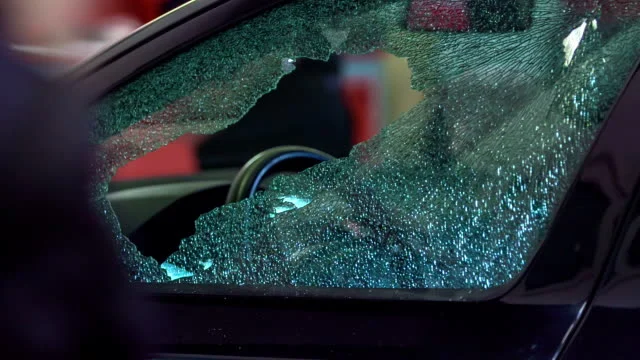Car Window Broken | Why Immediate Attention is Essential
Addressing the issue of car window broken is crucial for several reasons. First and foremost, a broken car window compromises the safety and security of both the vehicle and its occupants. It exposes the interior to external elements, such as rain, wind, and even potential theft or vandalism. Additionally, a shattered or cracked window can obstruct visibility, increasing the risk of accidents on the road. Furthermore, leaving a window unrepaired can lead to further damage to the vehicle’s interior, such as water damage or rust. Therefore, taking immediate action to repair or replace a broken car window is essential to ensure the safety, security, and longevity of the vehicle.
Understanding Car Window Broken Causes

Common reasons for car window breakage:
Impact: Objects like rocks, gravel, or debris kicked up by other vehicles can hit car windows, causing them to break.
Accidents: Collisions or crashes can shatter car windows due to the force of impact. If your car windshield is accidentally damaged or shattered, it’s important to repair or replace it immediately for your safety. A properly functioning windshield protects you from injuries and ensures your safety on the road.
Vandalism: Deliberate acts of vandalism, such as smashing windows with blunt objects, can cause damage.
Extreme temperatures: Sudden changes in temperature or exposure to extreme heat or cold can weaken the glass, leading to cracks or breakage.
Defective glass: Poor quality or defective manufacturing of car windows can make them more prone to breakage.
Factors contributing to car window vulnerability:
Type of glass: Some cars use tempered glass, which is stronger and more resistant to breakage, while others use laminated glass, which offers better protection against shattering but may still crack upon impact.
Vehicle design: The design of the vehicle, including the curvature of the windows and their proximity to potential impact points, can affect their vulnerability to breakage.
Driving conditions: Driving on rough roads or in areas with heavy construction or debris increases the risk of objects hitting and damaging car windows.
Maintenance: Neglecting maintenance such as replacing worn-out weather stripping or seals can leave windows more vulnerable to damage from external elements.
Environmental factors: Exposure to environmental elements such as sunlight, rain, and hail over time can weaken the glass and make it more susceptible to breakage.
Immediate Steps to Take When Your Car Window is Broken
Immediate Steps to Take When Your Car Window is Broken:
Ensuring safety and security:
- Park your car in a safe location away from traffic if possible.
- Turn on hazard lights to alert other drivers of the situation.
- If the broken glass poses a risk of injury, avoid touching it directly.
- Secure any valuable items in your car to prevent theft or damage.
Assessing the extent of the damage:
- Inspect the broken window to determine if it’s shattered or cracked.
- Check if there are any additional damages to the surrounding area or interior of the car.
- Assess if the damage affects the functionality of any safety features like airbags or sensors.
Temporary measures to protect your vehicle:
- Cover the broken window with a temporary barrier such as a trash bag or cardboard to prevent debris from entering and to deter theft.
- If the window is completely shattered, vacuum up any loose glass particles from inside the car.
- Contact a professional auto glass repair service as soon as possible to schedule repairs or replacement.
- Consider filing a police report, especially if the damage appears to be vandalism or if any items were stolen from the vehicle.
Repairing a Broken Car Window
DIY vs. professional repair options:
When it comes to repairing a broken car window, you have two main options: DIY or professional repair. DIY can be cost-effective if you have the necessary skills and tools, but it also carries the risk of improper installation or further damage. Professional repair ensures expertise and often comes with a warranty, but it can be more expensive.
Costs associated with car window repair:
The costs of repairing a car window can vary depending on factors such as the type of window, the extent of damage, and whether you opt for DIY or professional services. DIY costs typically include the price of replacement glass and any additional materials needed, while professional repair costs may include labor fees and markup on parts.
Steps involved in repairing a broken car window:
Gathering necessary materials: Before starting the repair process, gather all the materials you’ll need, including replacement glass, gloves, safety glasses, a vacuum cleaner, masking tape, and a sealant/adhesive.
Removing broken glass: Carefully remove any remaining glass from the window frame using gloves and a vacuum cleaner to minimize the risk of injury. Be thorough in cleaning out any debris.
Installing a replacement window: Position the replacement window in the frame, ensuring it fits securely. Use masking tape to hold it in place temporarily. Apply a suitable adhesive or sealant around the edges of the window to create a watertight seal. Allow sufficient time for the adhesive to cure before testing the window.
How to Cover a Broken Car Window Temporarily
Materials Needed:
- Large piece of cardboard, plywood, or heavy-duty plastic sheet
- Duct tape or strong adhesive tape
- Plastic garbage bags or tarp
- Scissors or utility knife
Step-by-Step Guide:
Assess the damage: Before attempting to cover the broken window, assess the extent of the damage and ensure there are no sharp edges that could cause injury.
Prepare the covering material: Cut a piece of cardboard, plywood, or heavy-duty plastic sheet slightly larger than the broken window to ensure full coverage.
Secure the covering: Place the covering material over the broken window from the inside of the car. Use duct tape or strong adhesive tape to secure the covering around the edges of the window frame. Make sure to press firmly to create a tight seal.
Reinforce if necessary: If the covering material is not thick enough to provide adequate protection, layer it with additional materials such as plastic garbage bags or a tarp. Secure these layers with more tape to strengthen the barrier.
Trim excess material: Use scissors or a utility knife to trim any excess material protruding from the edges of the covering to ensure a neat and secure fit.
Test the covering: Once the temporary covering is in place, carefully open and close the car door to ensure that it does not interfere with the operation of the window mechanism.
Monitor the covering: Keep an eye on the temporary covering to ensure it remains secure and effective until a permanent repair can be made.
Precautions:
Handle broken glass with care: When removing any remaining glass from the window frame, wear gloves and take precautions to avoid injury.
Be cautious of sharp edges: Broken glass can leave sharp edges around the window frame, so use caution when applying the temporary covering to avoid cuts or injuries.
Avoid obstructing visibility: Ensure that the temporary covering does not obstruct your visibility while driving, especially if the car window broken is in a rear or side position.
Seek professional repair: While temporary solutions can provide a quick fix, it’s essential to seek professional repair as soon as possible to ensure the safety and security of your vehicle. For professional window repair or replacement services contact Reliable Auto Glass which is best in the business.
Conclusion
Car window broken, it becomes paramount to emphasize the significance of timely and proper car window maintenance and repair. Neglecting such upkeep not only compromises the aesthetics of the vehicle but also exposes it to potential risks and vulnerabilities. Regular inspections and prompt repairs help prevent unexpected incidents like shattered windows, which can lead to safety hazards and inconvenience. Feel free to contact us for any type of services or query related to car window broken.
FAQs
What Should I Do If My Car Window Is Broken?
If your car window is broken, it’s essential to stay calm and assess the situation. Secure the vehicle and remove any glass debris from the interior. Then, cover the broken window with a temporary barrier, such as a plastic sheet or cardboard, to prevent further damage or exposure to elements.
What Are The Common Causes Of A Broken Car Window?
A broken car window can result from various factors, including vandalism, accidents, attempted theft, extreme weather conditions like hail or storms, or even a stray object hitting the window while driving.
Can I Drive My Car With A Broken Window?
It’s generally not safe to drive with a broken car window, as it compromises the structural integrity of the vehicle and exposes occupants to potential hazards. If necessary, drive cautiously to a nearby repair shop or arrange for a professional to assess and repair the window as soon as possible.
How Much Does It Cost To Repair A Broken Car Window?
The cost of repairing a broken car window can vary depending on factors such as the extent of damage, the type of vehicle, and the quality of materials used for the repair. It’s recommended to obtain estimates from reputable auto glass repair shops to determine the exact cost.
Does car insurance cover the cost of repairing a broken window?
In many cases, comprehensive car insurance policies cover the cost of repairing or replacing a broken car window, subject to deductibles and policy terms. Check with your insurance provider to understand the coverage and any applicable claims process.
How Long Does It Take To Repair A Broken Car Window?
The time required to repair a broken car window depends on factors such as the availability of replacement parts, the extent of damage, and the workload of the repair shop. In some cases, minor repairs can be completed within a few hours, while more extensive damage may require additional time.

